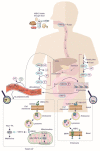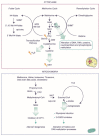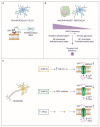Vitamin B12 Deficiency and the Nervous System: Beyond Metabolic Decompensation-Comparing Biological Models and Gaining New Insights into Molecular and Cellular Mechanisms
- PMID: 38203763
- PMCID: PMC10778862
- DOI: 10.3390/ijms25010590
Vitamin B12 Deficiency and the Nervous System: Beyond Metabolic Decompensation-Comparing Biological Models and Gaining New Insights into Molecular and Cellular Mechanisms
Abstract
Vitamin B12 (VitB12) is a micronutrient and acts as a cofactor for fundamental biochemical reactions: the synthesis of succinyl-CoA from methylmalonyl-CoA and biotin, and the synthesis of methionine from folic acid and homocysteine. VitB12 deficiency can determine a wide range of diseases, including nervous system impairments. Although clinical evidence shows a direct role of VitB12 in neuronal homeostasis, the molecular mechanisms are yet to be characterized in depth. Earlier investigations focused on exploring the biochemical shifts resulting from a deficiency in the function of VitB12 as a coenzyme, while more recent studies propose a broader mechanism, encompassing changes at the molecular/cellular levels. Here, we explore existing study models employed to investigate the role of VitB12 in the nervous system, including the challenges inherent in replicating deficiency/supplementation in experimental settings. Moreover, we discuss the potential biochemical alterations and ensuing mechanisms that might be modified at the molecular/cellular level (such as epigenetic modifications or changes in lysosomal activity). We also address the role of VitB12 deficiency in initiating processes that contribute to nervous system deterioration, including ROS accumulation, inflammation, and demyelination. Consequently, a complex biological landscape emerges, requiring further investigative efforts to grasp the intricacies involved and identify potential therapeutic targets.
Keywords: antioxidants; cellular metabolism; energy balance; metabolic decompensation; nervous system homeostasis; neurodegeneration; nutrients; oxidative stress; vitamin B12.
Conflict of interest statement
The authors declare no conflict of interest.
Figures






References
-
- Kräutler B. Sub-Cellular Biochemistry. Volume 56. Springer; Berlin/Heidelberg, Germany: 2012. Biochemistry of B12-Cofactors in Human Metabolism; pp. 323–346. - PubMed
-
- Andrès E., Federici L., Affenberger S., Vidal-Alaball J., Loukili N.H., Zimmer J., Kaltenbach G. B12 Deficiency: A Look beyond Pernicious Anemia. J. Fam. Pract. 2007;56:537–542. - PubMed
Publication types
MeSH terms
Substances
LinkOut - more resources
Full Text Sources

